
© Ian Douglas. (Click image for larger version)
Yasuko Yokoshi
Bell
New York, New York Live Arts
16 March 2013
Yasuko Yokoshi at John Simon Guggenheim Foundation
www.newyorklivearts.org
Of Maidens and Bells
Some experiments sound better on paper – especially when one admires the artist behind them – than they turn out to be in reality. In her new work, Bell, the downtown artist Yasuko Yokoshi has undertaken to explore elements of the ballet Giselle and the Kabuki drama The Maiden at the Dojoji Temple side by side. Yokoshi’s parallel structure sounds intriguing (though admittedly perilous). And Yokoshi is an intelligent and experienced experimentalist who has made such hybridizations work in the past, though, it must be said, ballet is new territory. The parallels are certainly striking: both works contain themes of betrayal, madness, transformation, and ghostly return. Both end with the striking of a bell, a symbol of truth (Christian or Buddhist) and transcendence. (In the program, a translated excerpt of Dojoji reads: “The bell in the early morning echoes a truth / beyond death, there is a promise of rebirth.” This is a sentiment Giselle’s ghost would recognize.) Both exist within extraordinarily rigorous aesthetic systems whose moral center lies at a remove from our contemporary life. On the one hand, Romantic ballet, with its spirits and turbulent yearnings, on the other, Kabuki, or more specifically Nihon buyo, the highly stylized dance element of Kabuki drama. Both require some deciphering, though the Kabuki form is decidedly more esoteric for a Western audience. Yokoshi’s format promises to illuminate some of its mysteries, while respecting its basic forms. She writes in the program: “I have no idea what [Dojoji] means or why it’s this way or why that way. Words are ambiguous and dance is more ambiguous than words.” In other words, in the spirit of conceptualism, she refuses to analyze or interpret. That is left to the viewer.
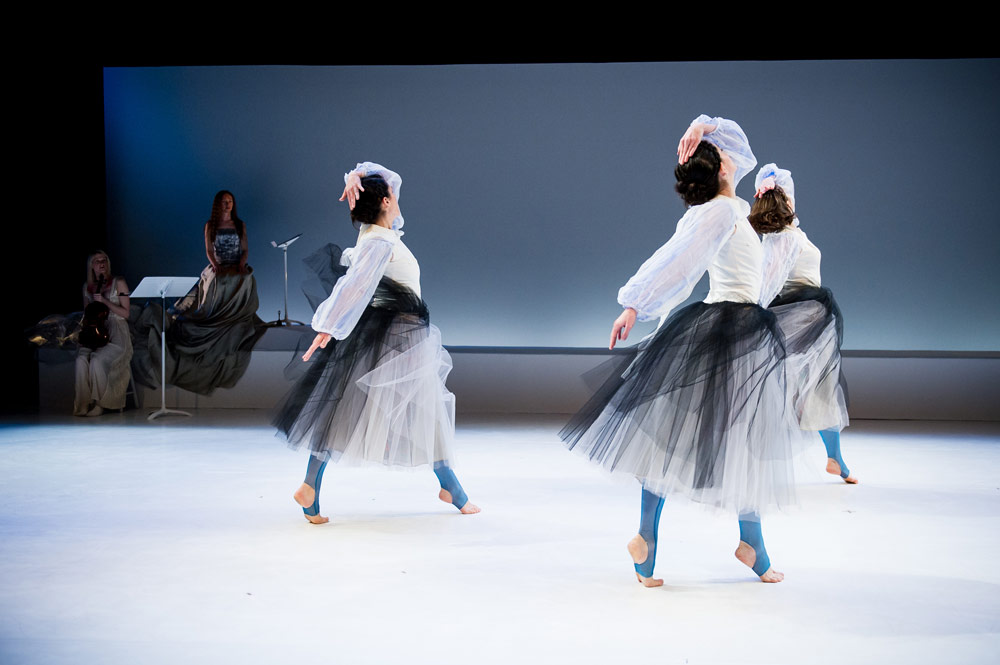
© Ian Douglas. (Click image for larger version)
Yokoshi is a Hiroshima-born experimentalist who has worked in New York since the nineties. Her early works were wild, avant-garde, out there. But in the last ten years she has changed her focus, devoting herself to the study of a stripped-down style of Kabuki called Su-odori, in which the performer dances while wearing a formal but simple kimono, without elaborate makeup or headdresses, on a plain stage. Like, say, the leotard ballets of Balanchine, Su-odori dispenses with the eye-catching elements of Kabuki – the colorful, opulent sets and costumes and dramatic onstage costume-changes – to bring attention to the choreography’s less spectacular elements and subtle architecture. The delicate hand gestures, the expert handling of the fan, the shifting of weight that transports the body from one position to another (like an articulated doll), the delicate foot and gliding step, the infinitely subtle use of the eyes. To Yokoshi, this austerity and restraint represents a kind of contemporaneity, a stripping-down akin to the experiments of the American post-modernists of the sixties and seventies. “You see the bones” of the dance, she said in a recent interview with Gia Kourlas.
Yokoshi has studied for a decade with Masumi Seyama VI, a disciple of Kanjyuro Fujima VI, an eminent choreographer of the Fujima School. In the three evening-length works she has made since then she has used a mixed cast of traditional Japanese dancers and musicians alongside American performers. Within this structure Yokoshi has performed solos taught to her by Seyama; it should be noted that it’s extremely unusual for a nihon buyo master to take on a student like Yokoshi, someone who is in her forties and has spent her entire career outside of the traditional Japanese dance system, a blank slate. Most practitioners (like ballet dancers) devote their entire lives to this form. So it was a dramatic leap of faith on Seyama’s part, and one that Yokoshi has honored by creating thoughtful, intriguing works over the years. What We, When We, based on a Raymond Carver short story, was especially poetic, suffused with the quiet profundity of an Ozu film.

© Ian Douglas. (Click image for larger version)
Alas, this is not true of Bell. From the beginning, the tone of Yokoshi’s new work feels off. Is this meant to be a parody of ballet? Is she poking fun at the dramatic, quasi-religious elements of Giselle, the churchyard, the ghosts, the girlish game of “he loves me, he loves me not”? Bell begins with a series of titles projected against a screen, an outline of the Dojoji story, accompanied by Adolphe Adam’s music for Giselle. If one knows the ballet, one recognizes the music that introduces the Wilis, or ghostly spirits of betrayed women, in act II. What sounds perfectly appropriate in the ballet here feels like melodramatic silent-movie music, an inside joke. Perhaps that’s the point. This is followed by the appearance of three American dancers (Julie Alexander, Lindsay Clark, and Jennifer Lafferty) wearing updated versions of Romantic, ankle-length tutus topped by bulky, rough-hewn blouses with puffy sleeves. (Was I the only one who found the cut of the shirts reminiscent of straightjackets, I wonder?) The women circle the stage, leaping, bourréeing, turning, in choreography that is blandly reminiscent of Giselle’s patterns. They are barefoot. (The movement language soon modulates toward more free-flowing Trisha Brown-like phrases). Later, the trio adds some of Giselle’s mime, cut up and reordered so that it becomes a series of disconnected phrases. The three women are perfectly good dancers, but certainly not ballerinas. There is something faintly depressing about their efforts. Again, one wonders if this is meant as parody and if not, what, exactly, it is trying to accomplish.
In contrast, the Japanese dancing is exquisite. Both Kayo Seyama, an older female dancer who performs a lengthy, delicate solo (called Kane no Misaki) toward the end of Bell, and Kuniya Sawamura, a young male dancer/actor who may just be one of the finest character dicers I have seen, are fascinating to watch. The utter control of every millimeter of their bodies and face, the refinement of their movements, the total clarity of the placement of each limb and adjustment of weight within the body, are astounding. To this, Sawamura adds an extraordinarily expressive face that suggests flickers of wit, sadness, irony, fear, pleasure, even naughtiness. His eyes, especially, are wondrously alive, articulate. I could have watched him for hours. Both he and Seyama wear plain gray and black kimonos. In contrast, Yokoshi, who performs two solos from the Dojoji story, wears stylishly fanciful Japanese-inspired designs by Akiko Iwasaki. One of her costumes is blinding red, with long sleeves, wide trousers, and a golden horn-shaped hat. The other, which resembles a jumper, has a black-and-white pebble pattern and is topped by an enormous platinum fright wig. The costumes (and elegant white set, also by Iwasaki) are one of the best elements of the show.

© Ian Douglas. (Click image for larger version)
The problem is that, next to the dancing of these two performers whose entire lives have been devoted to a single style, Yokoshi’s own, quietly lyrical dancing pales significantly. One can’t help but notice a certain tension in her body and lack of specificity in her movement, especially her hands. Perhaps, again, this contrast is intentional, but nevertheless it has the unfortunate effect of reminding us of what is lost when a traditional form is appropriated by an outsider, even one with the highest integrity. The same is true for the musicians, who, again, come from both traditions. A violist (Pinky Weitzman) plays the melody from Giselle’s second-act pas de deux, with shaky intonation; a vocalist, Gelsey Bell, sings, mostly in Japanese. But how much more compelling is the singing of the traditional vocalist Sanshichiro Kineya, with its wild extremes of inflection, accents, and range of tonal quality. Though it is impossible for me to judge the quality of the playing of the Japanese musicians, its colors seemed infinitely more varied, more detailed and crisp than that of the two westerners.
The high-point of Bell, oddly, comes when the American vocalist, Gelsey Bell, sings the lyrics to Lady Gaga’s oddly topical Bad Romance: “I want your ugly, I want your disease…I want your love, and I want your revenge.” The three western dancers flank Sawamura, who continues to dance his delicate solo, seemingly oblivious to what is going on around him. Or is he? A slight swaying looseness seems to infuse his movements; his eyes develop a mischievous gleam. And yet the accent never changes; the movements never become vulgar, even as tiny echoes seem to emerge between Sawamura’s gestures and those of the three women behind him. In this striking moment, a strange conversation between the two languages seems possible.
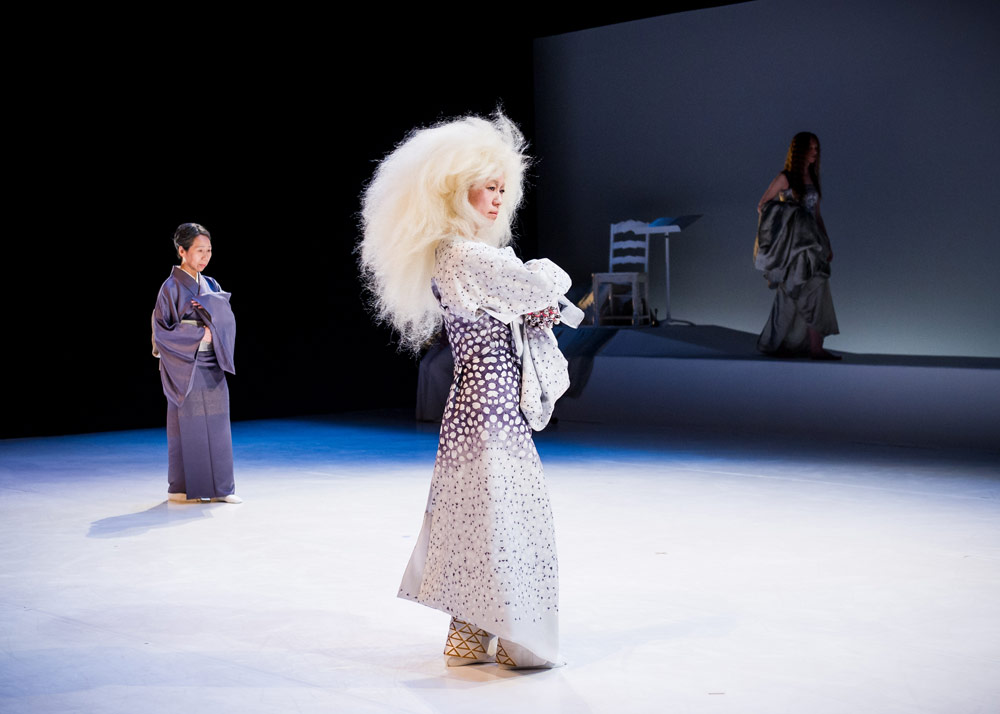
© Ian Douglas. (Click image for larger version)
Specificity is an issue with any hybrid work. Both Kabuki and ballet are highly specific forms; how does one honor and reveal the gestural language of each within this post-modern frame? In Nihon buyo, the movement suggests, but does not really explicate, the feelings and events of the story. In other words, it is “pure” dance, like the non-narrative passages of ballet. But Kabuki, unlike ballet, is also spoken theatre. Throughout the performance, there is chanted and sung text to accompany the action. If we have no idea what is being said, how can we fully experience the poetic resonances of the dance? This is one of the great challenges of presenting Japanese dance in the west. Other Kabuki shows I’ve seen have found ways of guiding the audience, through the use of supertitles or translated recitation. By opting against translation of any kind, Yokoshi weakens the power of the solos; one can intuit but never fully grasp the narrative elements of the dance, or experience the tiny epiphanies that occur when a physical gesture and its corresponding textual image come together in poetic harmony.
About the English text, the less said the better. At one point, the three American dancers re-enact a short scene from Dojoji, asking, in the voice of vapid teen-agers, whether the maiden before them (Yokoshi) should be allowed into the temple. “She is soooo beautiful,” one of them says, sounding like a character in Gossip Girl. “Is she a dancing girl?” another one asks, swiveling her hips. The coarseness of the exchange, after a delicate scene between Yokoshi and Sawamura, in which she lip-syncs along to the sounds of his skillfully-inflected voice, comes as a blunt shock. Is this really all that western postmodernism has to offer in exchange for the precise, sometimes impenetrable art of the past?













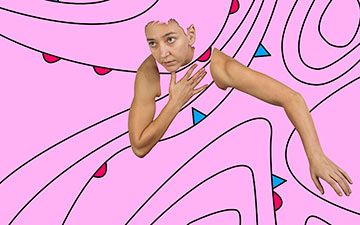
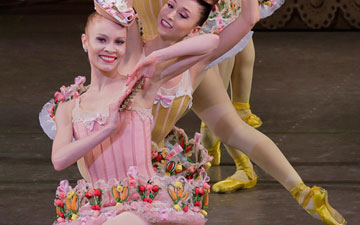

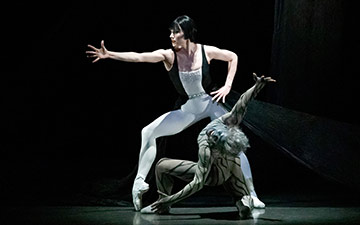
You must be logged in to post a comment.